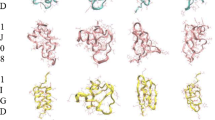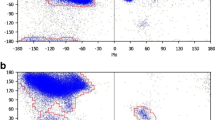Abstract
The relative importance of short- and long-range interactions is examined using a Monte Carlo simulation of protein folding on bovine pancreatic trypsin inhibitor. The model of the protein and the interaction energies were parametrized using X-ray structures of 30 native proteins. A nearest neighbor Ising model is used to determine the conformational state at each stage of the Monte Carlo procedure. Long-range interactions are simulated by contact free energies which become effective as two residues, separated by four or more residues along the chain, approach each other, and by disulfide-bond energies. Short-range interactions for residues separated by one, two, or three residues along the chain are also modeled by contact free energies and by α-helical hydrogen bonds. A hard-sphere model is used to represent repulsive interactions. The ratios of short- to long-range interactions studied are 1:1, 2:1, 1:2, 0:1, and 1:0; e.g., for the 2:1 ratio, short-range interactions are weighted twice as much as long-range interactions, and for the 1:0 ratio, long-range interactions are omitted. For each ratio of short- to long-range interactions, a “native” conformation is found by a Monte Carlo procedure, a segment of 11 residues (residue numbers 1–11) is then rotated away from the rest of the molecule [breaking the 5–55 native disulfide bond, and moving this segment so that the distance between the sulfur atoms of the 5 and 55 cystine side chains (averaged for all “native” conformations) increases from 3.9 to 7.3 Å], and the Monte Carlo simulation is carried out (allowing the conformation of the whole molecule to change) until equilibrium is attained. For each ratio, the refolded conformation is compared to the “native” one using triangular distance maps and differential geometry distance criteria. With ratios of short- to long-range interaction energies of 1:1 and 0:1, the native disulfide bond could be re-formed; with ratios of 2:1 and 1:2 it did not; and with the 1:0 ratio, even a stable “native” conformation was not achieved. Therefore, long-range interactions (in addition to short-range ones) are required to bring remote parts of the protein together and to stabilize its native conformation.
Similar content being viewed by others
References
Burgess, A. W., and Scheraga, H. A. (1975).Proc. Natl. Acad. Sci. USA 72, 1221–1225.
Chou, P. Y., and Fasman, G. D. (1974).Biochemistry 13, 222–245.
Crippen, G. M. (1977).Macromolecules 10, 25–28.
Gō, N., and Taketomi, H. (1978).Proc. Natl. Acad. Sci. USA 75, 559–563.
Hagler, A. T., and Honig, B. (1978).Proc. Natl. Acad. Sci. USA 75, 554–558.
Honig, B., Ray, A., and Levinthal, C. (1976).Proc. Natl. Acad. Sci. USA 73, 1974–1978.
Kotelchuck, D., and Scheraga, H. A. (1968).Proc. Natl. Acad. Sci. USA 61, 1163–1170.
Levitt, M. (1976).J. Mol. Biol. 104, 59–107.
Levitt, M., and Warshel, A. (1975).Nature 253, 694–698.
Lewis, P. N., Momany, F. A., and Scheraga, H. A. (1971).Proc. Natl. Acad. Sci. USA 68, 2293–2297.
Meirovitch, H., and Scheraga, H. A. (1981a).Macromolecules 14, 1250–1259.
Meirovitch, H., and Scheraga, H. A. (1981b).Proc. Natl. Acad. Sci. USA 78 6584–6587.
Metropolis, N., Roseubluth, A. W., Rosenbluth, M. N., Teller, A. H., and Teller, E. (1953).J. Chem. Phys. 21, 1087–1092.
Momany, F. A., McGuire, R. F., Burgess, A. W., and Scheraga, H. A. (1975).J. Phys. Chem. 79, 2361–2381.
Northrup, S. H., and McCammon, J. A. (1980).Biopolymers 19, 1001–1016.
Pottle, C., Pottle, M. S., Tuttle, R. W., Kinch, R. J., and Scheraga, H. A. (1980).J. Computational Chem. 1, 46–58.
Rackovsky, S., and Scheraga, H. A. (1978).Macromolecules 11, 1168–1174.
Rackovsky, S., and Scheraga, H. A. (1980).Macromolecules 13, 1440–1453.
Scheraga, H. A. (1973).Pure Appl. Chem. 36, 1–8.
Swenson, M. K., Eurgess, A. W., and Scheraga, H. A. (1978). In Pullman, B. (ed.),Frontiers in Physicochemical Biology (Proc. Int. Symp. 1977). Academic Press, New York, pp. 115–142.
Taketomi, H., Ueda, Y., and Gō, N. (1975).Int. J. Peptide and Protein Res. 7, 445–459.
Tanaka, S., and Scheraga, H. A. (1975).Proc. Natl. Acad. Sci. USA 72, 3802–3806.
Tanaka, S., and Scheraga, H. A. (1976a).Macromolecules 9, 142–159.
Tanaka, S., and Scheraga, H. A. (1976b).Macromolecules 9, 159–167.
Tanaka, S., and Scheraga, H. A. (1976c).Macromolecules 9, 168–182.
Tanaka, S., and Scheraga, H. A. (1976d).Macromolecules 9, 945–950.
Tanaka, S., and Scheraga, H. A. (1977a).Macromolecules 10, 291–304.
Tanaka, S., and Scheraga, H. A. (1977b).Proc. Natl. Acad. Sci. USA 74, 1320–1323.
Ueda, Y., Taketomi, H., and Gō, N. (1978).Biopolymers 17, 1531–1548.
Wako, H., and Scheraga, H. A. (1981).Macromolecules 14, 961–969.
Wako, H., and Scheraga, H. A. (1982a).J. Protein Chem.,1, 85–117.
Wako, H., and Scheraga, H. A. (1982b).Biopolymers 21, 611–632.
Warme, P. K., and Morgan, R. S. (1978).J. Mol. Biol. 118, 289–304.
Zimmerman, S. S., Pottle, M. S., Némethy, G., and Scheraga, H. A. (1977).Macromolecules 10, 1–9.
Author information
Authors and Affiliations
Additional information
NIH Postdoctoral Fellow, 1977–1978.
Rights and permissions
About this article
Cite this article
Anderson, J.S., Scheraga, H.A. Effect of short- and long-range interactions on protein folding. J Protein Chem 1, 281–304 (1982). https://doi.org/10.1007/BF01039553
Received:
Published:
Issue Date:
DOI: https://doi.org/10.1007/BF01039553




